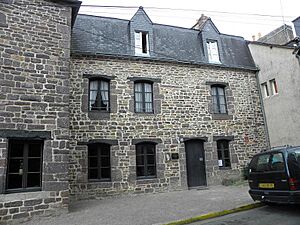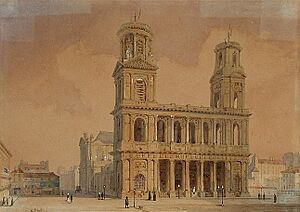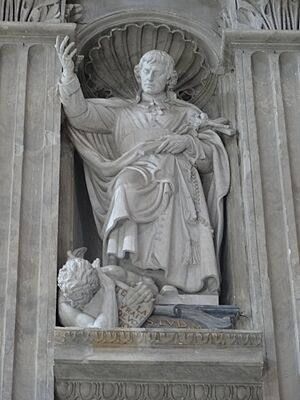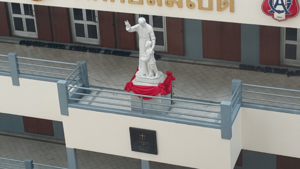Louis de Montfort facts for kids
Quick facts for kids SaintLouis-Marie Grignion de Montfort TOSD |
|
|---|---|
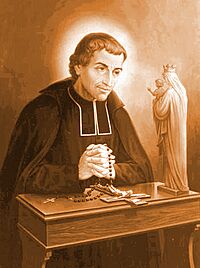 |
|
| Born | 31 January 1673 Montfort-sur-Meu, France |
| Died | 28 April 1716 (aged 43) Saint-Laurent-sur-Sèvre |
| Venerated in | Roman Catholic Church |
| Beatified | 1888 by Pope Leo XIII |
| Canonized | 20 July 1947 by Pope Pius XII |
| Feast | 28 April |
Louis-Marie Grignion de Montfort (born January 31, 1673 – died April 28, 1716) was a French Catholic priest. He was famous for his powerful preaching and his special focus on Mariology, which is the study of Mary, the mother of Jesus.
Pope Clement XI made him a "missionary apostolic," meaning he was sent to preach the Catholic faith. Montfort wrote several important books that are still popular today and influenced many popes. His most well-known books about devotion to Mary are Secret of the Rosary and True Devotion to Mary.
Pope Pius XII declared him a saint on July 20, 1947. You can find a statue of him in St. Peter's Basilica in Rome.
Contents
Early Life and Education
Louis-Marie Grignion de Montfort was born in 1673 in Montfort-sur-Meu, France. He was the oldest of eighteen children born to Jean-Baptiste and Jeanne Robert Grignion. His father worked as a notary, which is someone who prepares legal documents.
Louis-Marie spent his early childhood in Iffendic, a town near Montfort. When he was 12, he started studying at the Jesuit College of St Thomas Becket in Rennes. His uncle was a priest there. After finishing his regular studies, he began learning philosophy and theology at the same college.
Inspired to Serve the Poor
While studying, Louis-Marie heard stories from a local priest, Abbé Julien Bellier. Bellier was an "itinerant missionary," meaning he traveled around preaching. These stories inspired Louis-Marie to want to preach to people who were very poor.
Abbé Bellier also taught his students about dedicating themselves to Mary. Under the guidance of Bellier and other priests, Louis-Marie developed a very strong devotion to the Blessed Virgin Mary.
Studies in Paris
In 1693, Louis-Marie got a chance to study in Paris at the famous Seminary of Saint-Sulpice. However, when he arrived, he found that his helper had not given him enough money. He had to live in cheap boarding houses among very poor people. He also attended theology lectures at the Sorbonne University.
After less than two years, he became very sick and had to go to the hospital. He recovered and was able to return to the Little Saint-Sulpice seminary in July 1695. This seminary was founded by Jean-Jacques Olier, a key figure in French spirituality.
Louis-Marie became the seminary's librarian. This job allowed him to read many books on spirituality, especially those about Mary's role in Christian life. This reading later led him to focus on the Rosary and write his famous book, The Secret of the Rosary.
Devotion to Angels
Even as a student, Montfort was known for respecting angels. He encouraged his friends to show kindness to their guardian angels. He often ended his letters by greeting the guardian angel of the person he was writing to. When he arrived in a new town, he would greet all the angels of that place.
This devotion to angels was part of his training and culture. His Jesuit teachers were keen on promoting devotion to angels. His Sulpician seminary training also connected him with the ideas of Cardinal de Bérulle and Olier, who also deeply respected angels.
From Priest to Preacher
Louis-Marie became a priest in June 1700 and was sent to Nantes. He really wanted to be a missionary in other countries, like the new French colony of Canada. But his spiritual guide told him not to go. Letters from this time show he felt frustrated because he didn't have enough chances to preach as he felt called to do.
In November 1700, he joined the Third Order of Saint Dominic. He asked for permission to preach the rosary and to form groups dedicated to the rosary. He started thinking about creating a small group of priests to preach missions and retreats under Mary's protection. This idea eventually led to the founding of the Company of Mary.
Around this time, Louis de Montfort became the chaplain of a hospital in Nantes. Here, he met Marie Louise Trichet, who would later dedicate 34 years to helping the poor. France was facing economic problems during Montfort's time, with a fast-growing population and not enough food.
Apostolic Missionary
Montfort wanted to be a missionary, so he traveled to Rome to ask Pope Clement XI for advice. The Pope saw that Montfort had a true calling. He told him there was plenty of work for him in France and sent him back with the special title of "Apostolic Missionary."
After his long trip to Rome, Montfort went on a retreat at Mont Saint Michel. He prayed to the archangel there to help him bring souls to God, strengthen those already in God's grace, and fight against evil. These quiet times helped him to think, pray, and write.
For several years, he preached missions from Brittany to Nantes. As his fame as a missioner grew, people called him "the good Father from Montfort." In Pontchateau, he gathered hundreds of people to help him build a huge calvary, which is a religious monument. However, just before it was to be blessed, the Bishop stopped it. The King of France, influenced by a group called the Jansenists, ordered it to be destroyed. When Montfort heard the news, he simply said, "Blessed be God."
Later Years and Legacy
After leaving Nantes, Montfort spent several very busy years. He was constantly preaching missions, always walking from one place to another. Despite this, he found time to write his important books: True Devotion to Mary, The Secret of Mary, and The Secret of the Rosary. He also wrote rules for the Company of Mary and the Daughters of Wisdom, and many hymns.
His missions had a great impact, especially in the Vendée region. Some people found his preaching style a bit unusual. He was even poisoned once, which made his health worse, but he kept going. He continued preaching and started free schools for poor boys and girls.
Founding the Daughters of Wisdom
The bishop of La Rochelle was impressed by Montfort and invited him to open a school there. Montfort asked for help from his follower, Marie Louise Trichet, who was managing a hospital in Poitiers. In 1715, Marie Louise and Catherine Brunet went from Poitiers to La Rochelle to open the school. Soon, it had 400 students.
On August 22, 1715, Trichet, Brunet, Marie Valleau, and Marie Régnier made their religious vows under Montfort's guidance. At the ceremony, Montfort told them, "Call yourselves the Daughters of Wisdom, for the teaching of children and the care of the poor." The Daughters of Wisdom grew into a worldwide organization.
Death and Burial
Montfort spent many months in solitude during his 16 years as a priest. He stayed in places like the cave of Mervent and hermitages near Montfort and La Rochelle.
Worn out by hard work and sickness, he arrived in Saint-Laurent-sur-Sèvre in April 1716 for what would be his last mission. During this mission, he became ill and died on April 28, 1716. He was 43 years old and had been a priest for only 16 years. His last sermon was about the kindness of Jesus. Thousands of people gathered for his burial in the parish church. Soon, there were stories of miracles happening at his tomb.
Exactly 43 years later, on April 28, 1759, Marie Louise Trichet also died in Saint-Laurent-sur-Sèvre and was buried next to Montfort. On September 19, 1996, Pope John Paul II visited their tombs to pray.
Montfort's Spirituality
Montfort's spiritual teachings can be summed up by a few key ideas:
- "God Alone": This was Montfort's motto and appears over 150 times in his writings.
- The Incarnation: He believed that God becoming human in Jesus was the most important event.
- Love of the Blessed Virgin Mary: He had a deep love for Mary.
- Fidelity to the Cross: He emphasized being faithful to the suffering and sacrifice of Jesus.
- Missionary Zeal: He had a strong desire to spread the Christian message.
Total Consecration to Jesus Through Mary
Montfort taught that Jesus and Mary are always connected. He saw "consecration to Jesus in Mary" as a special way to become more like Christ. He believed that because Mary is the most like Jesus, devotion to her helps a person become more devoted to Jesus.
He famously wrote:
God the Father made an assemblage of all the waters, and He named it the sea (mare). He has made an assemblage of all His graces, and He has called it Mary (Maria).
Montfort believed that "Mary is the safest, easiest, shortest, and most perfect way of approaching Jesus."
His "total consecration" process involves seven steps, including understanding one's own weaknesses, sharing Mary's faith, and trusting God and Mary completely. It aims to transform a person to be more like Jesus. This practice includes both inner surrender to Mary and outer actions, like joining Marian groups or giving to charity in Mary's honor.
Influence on Popes
Louis de Montfort influenced many popes. In the 19th century, Pope Pius IX thought his way of devotion to Mary was the best. Pope Leo XIII even granted special blessings for those who practiced Montfort's method. Leo beatified Montfort in 1888.
In the 20th century, Pope Pius X said Montfort's writings helped him write his own important letter, Ad diem illum. Pope Pius XI said he had followed Montfort's methods since he was young. Pope Pius XII declared Montfort a saint and called him a guide who leads people to Mary and then to Jesus.
Pope John Paul II often spoke about Montfort's influence. He recalled reading Montfort's work as a young student and realizing he couldn't leave Mary out of his life. John Paul II's personal motto, "Totus Tuus" (meaning "Totally Yours"), was inspired by Montfort's teachings.
His Writings
Montfort wrote many books and letters that are still read today. Some of his most famous works include:
- Preparation for Total Consecration according to Saint Louis de Montfort
- Secret of the Rosary
- The Love of Eternal Wisdom
- The Secret of Mary
- True Devotion to Mary
Priest and Poet
Besides his spiritual writings, Montfort was also a poet. During his missions, he wrote more than 20,000 lines of hymns. These hymns were meant to be sung in village churches and in the homes of poor people. Some experts believe that reading Montfort's hymns helps us understand him better and appreciate his spiritual ideas.
Montfort's hymns are often divided into two types: "inspired" and "didactic." Inspired hymns were written spontaneously, perhaps during a pilgrimage or a joyful event. Didactic hymns took more effort and were designed to teach and inform people, often using a moral lesson. After Montfort's death, the Company of Mary used his hymns to continue their work of spreading the Christian faith.
He is also said to have carved at least three statues of Mary and the Child Jesus.
Montfort's Congregations
The religious groups Montfort started continued to grow and spread after his death. These include:
- The Company of Mary (for priests and brothers)
- The Daughters of Wisdom (for sisters)
- The Brothers of Saint Gabriel (which grew from a group of lay brothers who worked with him)
These groups spread from France to many other parts of the world. The Servants of the Lord and the Virgin of Matará also follow Montfort's spiritual teachings.
Montfort's birthplace and his tomb are now popular places for pilgrimages, with about 25,000 visitors each year. His birth home in Montfort-sur-Meu is now owned by the three religious groups he founded. The Basilica of Saint Louis de Montfort in Saint-Laurent-sur-Sèvre also attracts many pilgrims.
Montfort is the patron saint of several well-known schools that educate young people. These include St. Gabriel's Secondary School and Montfort Secondary School in Singapore, the Assumption College in Thailand, and the Montfort Academy in New York.
Biographies of Montfort
More than a hundred biographies have been written about Montfort. They show how different times and cultures influenced how his life story was told.
The first four biographies were written in the 1700s. They were "devotional biographies," meaning they aimed to praise and idealize him. While they might not have been perfectly accurate, they saved important eye-witness accounts and documents.
In the 1800s, biographies focused more on his inner spiritual journey. Later, in the 20th century, authors like Louis Perouas tried to describe Montfort's life using a more historical and psychological approach. Perouas suggested that Montfort's life was difficult, partly because of a strained relationship with his father. However, his understanding of Montfort's ministry in the context of his time is generally well-accepted.
Images for kids
See also
 In Spanish: Luis María Grignion de Montfort para niños
In Spanish: Luis María Grignion de Montfort para niños
- Saint Louis de Montfort's Prayer to Jesus


